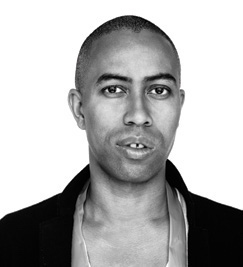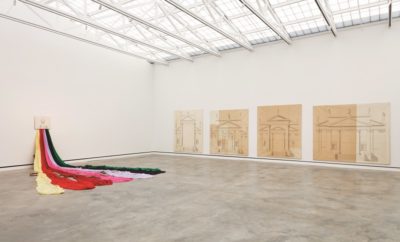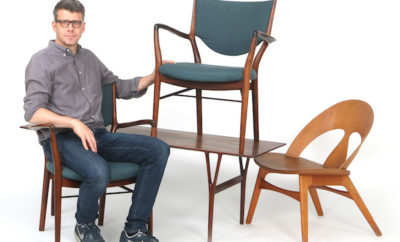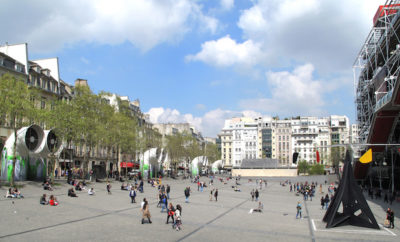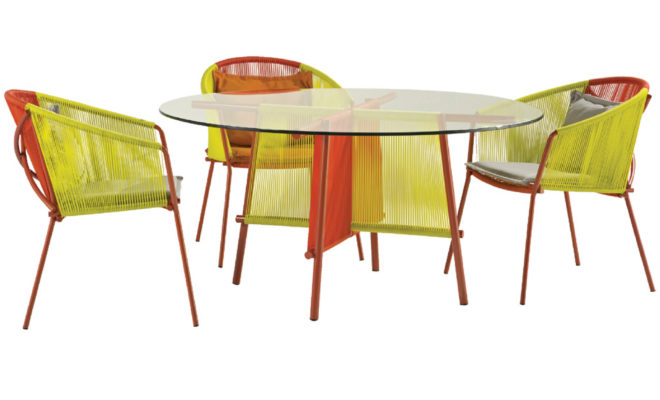 Set of round table and chairs included in Burks’s Traveler collection for Roche Bobois.Photo courtesy of Roche Bobois
Set of round table and chairs included in Burks’s Traveler collection for Roche Bobois.Photo courtesy of Roche Bobois
Feature
The Evolution and Revolution of Stephen Burks
DESCRIBING STEPHEN BURKS’S work can be quite difficult, if for no other reason than that it changes dramatically with each new project or collaboration. Over the past decade, the designer behind the eponymous Stephen Burks Man Made studio has joined forces with basket weavers in Senegal and artisans in Peru and India, earning him a Cooper Hewitt National Design Award last year, along with growing recognition around the globe. And he’s kept the momentum up, most recently debuting his Noir pendant lights at Armory Design Projects in March. The lamps embody his analog-meets-digital approach—Burks designed each of the three sizes digitally, but had artisans hand-rub them with graphite to achieve a deep sheen. “Those touches for me allow the viewer to imagine that the object comes from a place of artistic impression,” he says. In other words? The line between art and design is so blurred now that it’s not even worth asking the question of which is which.
He also designed the central lounge at the Armory Show this past spring by bringing back an old collaboration—his Dala for Dedon collection of ottomans, side tables, and stools. The furniture is comprised of fibers created from recycled food and drink packaging and expertly woven by Philippine artisans—all, of course, in Burks’s signature bright colors of turquoise, ocher, and burnt orange.
One thing’s for certain: the Brooklyn-based designer is always looking to forge new pathways and new partnerships, as evidenced by his collaborations with such brands as Harry Winston, Swarov-ski, and Missoni. Most recently he’s paired with the famed French furniture brand Roche Bobois— coincidentally, the company’s first collaboration with an American designer in its storied forty-year history. Burks traveled to Indonesia with Nicolas Roche himself to garner inspiration for the Traveler collection of outdoor chairs.
We caught up with Burks at the Roche Bobois Madison Avenue flagship store to talk about the Traveler collection, craft, color, and the process of creation, as well as the seismic shift happening in the design world.
Beth Stebner/MODERN Magazine: Tell me about the Traveler collection—it’s so colorful!
Stephen Burks: I love color, I love pattern, I love texture. For me, the Traveler line takes the iconic Roche Bobois brand and transforms it, taking inspiration from the desire to bring a little piece of paradise home with you after your travels. To me, color communicates a kind of humanity, a dynamic sense of place coming from real culture and real people, and not necessarily something that could be pumped out by a machine. There’s also a cultural legibility at work when we exhibit how things are made. Cord going around and around a tube catches the imagination and makes you wonder, “Where did this come from?” What luxury is for me today is how something is made. You can trace this production back to a people and a culture and a way of making that is timeless.
MM: You’ve collaborated with such nonprofits as Aid to Artisans and the Clinton Global Initiative— among others—and that, in turn, has led you to work with artisans from Peru to Indonesia. But you’ve been very clear that it’s not charity.
SB: We believe in trade, not aid. We’re not interested in donating to communities, we’re interested in collaborating with makers who have strong contributions to make and in helping them see how design can extend craft traditions into the future. We make no distinction between a European artisan and an African artisan. Plugging into the brands we work with is our way of making the connections to those in the diaspora. I want to engage different points of view and different communities and different cultures.
MM: What kinds of challenges do you encounter as a minority designer?
SB: It’s fantastic that I was able to break through, but it’s sad how closed and monocultural the design world is. When any industry lacks diversity, it tends to close doors. Design needs to be more inclusive. I’ve always believed everyone is capable of design. Rather than saying “Euro-styling,” we need to say things like “pluralistic” and “multicultural” because probably 99.9% of the world lives without the luxury of having “design.” Although everything around them is designed, it may lack a kind of consciousness. Where and when will we see the next wave of design revolution? Africa, Asia, South America? This is what I hope to participate in.
MM: Walk me through your creative process, from idea to implementation.
SB: I like starting from zero. I don’t have a signature style, I’m not a formalist, per se. I’m really interested in finding the right balance between my own point of view and that of the collaborators we work with. Sometimes it’s a sketch, sometimes it’s a collage, a photograph. Innovation for me comes through greater proximity with the making—the closer we can get to the act of making, the greater potential we have for innovation.
MM: Can you talk about your use of color in your designs?
SB: As I said, I love color and pattern and texture. But when people say [my] design is always colorful, they miss the point. It’s reductive. It’s not always going to be colorful, or a woven texture. This isn’t a trend for me, this is a revolutionary and evolutionary process, and really about returning the hand to industry.
MM: What’s your favorite piece of furniture in your apartment?
SB: I tend to surround myself with other people’s work at home. It’s a toss-up between my Vitsoe 606 shelving system because it really works and it’s so functional, and my Jean Prouvé dining table. Of my own designs I’m partial to the Anwar floor lamp, because it’s such a sculptural object and it really is a thing before it’s a lamp. Anwar’s also the name of my son, and it means “luminous” in Arabic.


